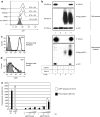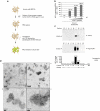Protein transfer into human cells by VSV-G-induced nanovesicles
- PMID: 21750535
- PMCID: PMC3182355
- DOI: 10.1038/mt.2011.138
Protein transfer into human cells by VSV-G-induced nanovesicles
Abstract
Identification of new techniques to express proteins into mammal cells is of particular interest for both research and medical purposes. The present study describes the use of engineered vesicles to deliver exogenous proteins into human cells. We show that overexpression of the spike glycoprotein of the vesicular stomatitis virus (VSV-G) in human cells induces the release of fusogenic vesicles named gesicles. Biochemical and functional studies revealed that gesicles incorporated proteins from producer cells and could deliver them to recipient cells. This protein-transduction method allows the direct transport of cytoplasmic, nuclear or surface proteins in target cells. This was demonstrated by showing that the TetR transactivator and the receptor for the murine leukemia virus (MLV) envelope [murine cationic amino acid transporter-1 (mCAT-1)] were efficiently delivered by gesicles in various cell types. We further shows that gesicle-mediated transfer of mCAT-1 confers to human fibroblasts a robust permissiveness to ecotropic vectors, allowing the generation of human-induced pluripotent stem cells in level 2 biosafety facilities. This highlights the great potential of mCAT-1 gesicles to increase the safety of experiments using retro/lentivectors. Besides this, gesicles is a versatile tool highly valuable for the nongenetic delivery of functions such as transcription factors or genome engineering agents.
Figures





Comment in
-
Gesicles: Microvesicle "cookies" for transient information transfer between cells.Mol Ther. 2011 Sep;19(9):1574-6. doi: 10.1038/mt.2011.169. Mol Ther. 2011. PMID: 21886114 Free PMC article. No abstract available.
References
-
- Wagstaff KM., and, Jans DA. Protein transduction: cell penetrating peptides and their therapeutic applications. Curr Med Chem. 2006;13:1371–1387. - PubMed
-
- Mäe M., and, Langel U. Cell-penetrating peptides as vectors for peptide, protein and oligonucleotide delivery. Curr Opin Pharmacol. 2006;6:509–514. - PubMed
-
- Liguori L., and, Lenormand JL. Production of recombinant proteoliposomes for therapeutic uses. Meth Enzymol. 2009;465:209–223. - PubMed
-
- Xu YF, Zhang YQ, Xu XM., and, Song GX. Papillomavirus virus-like particles as vehicles for the delivery of epitopes or genes. Arch Virol. 2006;151:2133–2148. - PubMed
Publication types
MeSH terms
Substances
LinkOut - more resources
Full Text Sources
Other Literature Sources
Research Materials

